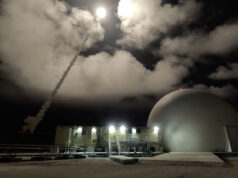Bell Textron Inc. has announced that the United States Army has approved the Milestone B decision for its Future Long Range Assault Aircraft (FLRAA), officially marking the beginning of the programme’s entry into the Engineering and Manufacturing Development (EMD) phase, according to a press release from the company.
This milestone, a key part of the Major Capability Acquisition process, signifies the start of the FLRAA’s journey as a Program of Record (PoR).
Bell’s Senior Vice President and FLRAA Program Director, Ryan Ehinger, described the achievement as a “historic moment for both the U.S. Army and Bell,” noting that the program is now on course to deliver what the company describes as “transformational capability to the warfighter.”
The FLRAA team, he added, is focused on closely collaborating with the Army to move forward with the next phase of development.
The press release outlines that the Milestone B decision comes after extensive work by Bell and its partners to refine the aircraft’s design, reduce risks, and align the system’s capabilities with the U.S. Army’s mission requirements. This work included a Preliminary Design Review (PDR), which was aimed at ensuring the integration and effectiveness of the aircraft’s various systems, including weapon design, sustainment, and system integration.
Colonel Jeffrey Poquette, FLRAA Project Manager, highlighted the collective effort behind reaching this stage, stating in the press release, “This significant milestone is made possible by the years of hard work and sacrifice by Team FLRAA and our teammates throughout the Army and the Department of Defense.” He added that the program is now entering an exciting phase where the focus will be on designing, building, and testing prototypes of the FLRAA.
Since the U.S. Army awarded Bell the FLRAA contract in December 2022, the company has established new facilities and manufacturing processes to support the program. As the project moves into the EMD phase, Bell’s efforts will concentrate on refining the aircraft’s design and progressing with prototyping.
According to the press release, the FLRAA is expected to offer significant advancements over the current fleet, with the new aircraft projected to fly twice as far and twice as fast.
The company attributes this performance to mature tiltrotor technology, an innovative digital engineering approach, and an open architecture, which it claims will make the FLRAA the most reliable, affordable, and high-performing long-range assault aircraft in the world.










This aircraft seems so bloody useful, I can not see why any country would ever want to use ordinary helicopters again ^.^
If it indeed proves reliable, and lessons learned from Osprey hopefully will get it there, then for a good proportion of roles especially where speed is a great advantage I tend to agree with you.
Can we re-start the Fairey Rotodyne we have the IP. And built a prototype 60 plus years ago. Range, speed etc check! Noise ok to be sorted out but was resolved at the time with different tip designs.
Helicopters are much cheaper to buy and to use, have much less down time and are less dangerous.
Because helicopter’s can still do some things that tilt rotors cannot.
1) the hover efficiency of a traditional rotor is significantly better than a tilt rotor..so if you have a role in which sustained hover is important a traditional rotor is better because a tilt rotor has a far greater disk loading, it means it needs more power, has greater fuel consumption for any given hover..so for something that is hovering a lot traditional rotors are better, no hiding behind a hill and sneaking up on a tank..or hunting a sub using a dipping sonar.
2) the increased disk loading also massively increases down wash that’s an operational issue. This means you cannot do things like roping from a tilt rotor or using a winch. So no rescuing a pilot or random person from the sea using a tilt rotor, no boarding operations from a tilt rotor.
2) complexity and maintaining, the tilt rotor will have a profoundly more complex drive shaft and gearing than a traditional rotor.
3) larger….most naval small ship flights are quite compact to operate from a small hanger space in the back of a frigate..
So although tilt rotors can go faster and longer distance than to traditional rotor, they are more inefficient lift wise and have a lot of operational shortcomings that means they cannot do everything a small ship flight medium rotor can…
All in all they are not a replacement they are an addition for your larger ships..amphibious vessels and carriers to specifically carry things a long distance.
The only issue I have is width and accessibility to certain terrain and closed in environments. However, the performance improvements are impressive.
Yes I don’t think the helicopter is quite dead yet.
I thought it wasn’t as wide as a Merlin was long, but I was wrong. A Merlin is 23m long and a Valor with rotors is 25m. Still, there’s not that much in it.
Possible replacement for chopper bourn Crownest. Possible tanker for carrier re-fuelling.
AEW, possibly; tanker, I doubt it. Even the V22 Osprey was too small to bother taking forward the VARS tanker option.
Fairy Rotodyne in half or full sizes please!
Tip jet rotors would benefit from digital control of fuel delivery. Fiarey had even gone someway to curing the noise problem. Again with modern modelling tools one would imagine that noise could be abated even further. An aircraft with C130 like capacities flying from a carrier? You would need between six and eight of such to lift one whole RM commando plus stores.
That’s subject to loadout. If it’s a splash and dash, five six-hour tasking and return, otherwise you end up having a helo do double journeys. The FLRAA competition, the Bell V-280 Valor tiltrotor demonstrator, just as in the V-22, demonstrated superior range and speed as compared to traditional rotorcraft, including the coaxial helicopter design it beat.
The US Army has achieved an ability based on its requirements for an aircraft that will deliver on assault missions. It is about putting troops and equipment on the ground. Its philosophy is if an aircraft exhibits greater payload, speed, and range than a competitor, then these capabilities will map to more troops and equipment on the ground, farther, and faster.
A second aspect of the assault mission is the ability to manoeuvre in a contested landing zone. Here, the Bell test team demonstrated that the V-280 demonstrator met and exceeded the current aeronautical design standards for agility that the US Army uses.
They learned a lot of lessons from the Osprey and claim the Valor couldn’t crash in the way the former did.
The UK needs these. It is far better than any helicopter we have. I have seen a video of troops in its internal bay, where it was unbelievably quiet. Much better than the boneshakers and deafening machines I have had the misfortune of flying in.
Yes for moving marines about, but no as a small ship flight. Operationally there are a lot of things a small ship fight needs to do that a tilt rotor will struggle with. But for amphibious operations from an assault ship or carrier, they are very worth while..a small ship fight from the back of a frigate…Merlin is better.